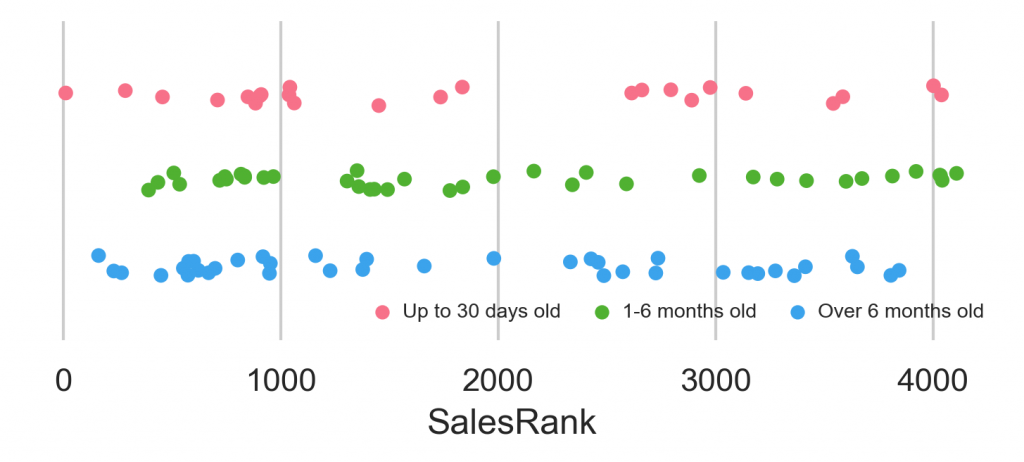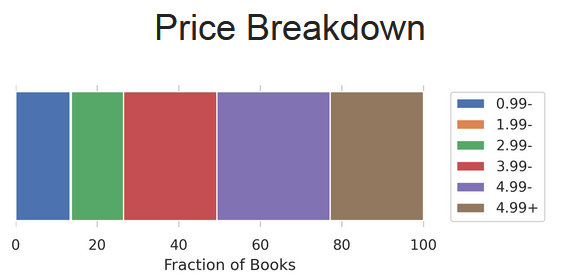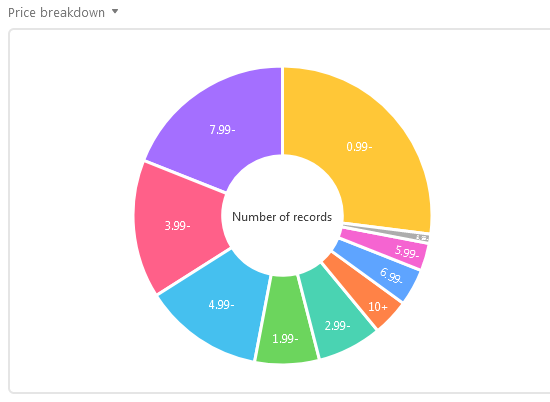The final part of our research discussion is about genre mechanics. By ‘mechanics’ I mean ‘everything else to do with your genre which isn’t specifically about your book’. That’s a lot of things, but I have chosen to separate it from the three previous parts (content, blurb, cover) because I think it’s valuable to learn how elements in each of those are linked to the preceding one.
To get an idea of the mechanics of your genre, let’s go through the following short topics:
Release frequency
How frequent are new books in the Top 100 for your genre? When you get a Kindletrends newsletter, keep track of how quickly books drop out of the Top 100, and click the link provided to quickly scan the new ones.
Age of books in the Top 100
The Best Sellers Rank plot in a Kindletrends newsletter can tell us a lot about how quickly a genre turns over:

The three rows of dots represent three different groups of books:
- The red row represents books up to 30 days old. During this period the books will be classed by Amazon as ‘new releases’, and will be eligible to appear on the separate ‘hot new releases’ list. It’s commonly believed that books within this period will be made more visible in searches and in ‘related content’ results on other books’ pages, although this is hard to quantify.
- The green row represents books between 1 month and 6 months old. This is the main part of the lifespan of most self-published books in most genres, and it’s the period where most books will earn most of their total lifetime revenue (although see below).
- The blue row represents ‘evergreen’ books over 6 months old. If a book is still in the Top 100 at this point, it is probably there because of factors other than just the title, cover and blurb. This might be because it’s by a well-known author, it might be being kept up by a large marketing budget, or it might be at the end of a series.
You can get a picture of the ‘churn’ in a genre by looking at the relationship between these three groups.
- High-churn genres (for instance, MF contemporary billionaire romance) will have a lot of red dots; this suggests that books in this genre make most of their revenue in the first 30 days, and also that you will need to write and release frequently to maintain steady income.
- Lower-churn genres (for instance, mystery genres) will have more green and blue dots, suggesting that releases need not be as frequent, but it may be harder to break into the Top 100.
Try looking at books from the three different groups to see if there are characteristic differences between them. You can click the links below the Best Sellers Rank plot to go straight to the books on the Kindle Store, or you can open the Dashboard, and filter books by the ‘Age category’ field. Also check the ‘isTradPublished’ field for an estimate of whether a book is traditionally published or not; trad books sometimes have more longevity than non-trad books, because they are being supported by an advertising campaign and potentially print book sales.
Kindle Unlimited vs wide
Some genres have a lot of KU books, up to ~100% (e.g. for short romance), while other genres can be close to 50/50 KU vs wide (e.g. historical romance). KU and wide books are often different in branding, so it’s a good idea to take note of the KU status when you’re choosing books to research. You can include or exclude KU books in the Dashboard by filtering on the ‘kuStatus’ field; as with the age of books, try looking at both KU and wide books in your genre to see if there are characteristic differences between them.
Traditionally-published books
As mentioned above, trad-published books may have a different lifespan to non-trad-published books in your genre, so it’s worth looking at both groups to get a sense of the differences. In the Dashboard, the ‘isTradPublished’ field is an estimate based on the publisher name: if it’s an imprint of one of the big publishing houses then it’s assumed to be ‘trad’. This isn’t perfect, and there are quite a few smaller publishing houses in some genres which also conform to traditional publishing market styles and standards, but it’s accurate enough to get a general sense of differences in a genre.
Standalone vs series
Some genres heavily favour writing books in a long series, to maximise readthrough. If you’re planning to do this, you may want to do specific ‘series research’: use the Dashboard to filter on the Series field and make it ‘is not empty’, to pull out all the books which are in a series. This is particularly useful for planning covers: cover design for a series can be challenging, because you need flexibility to substitute in different elements for each book, while retaining other ones to maintain obvious series branding.
Page length
You can see the median page length for all the books in the Top 100 at the bottom of the ‘nPages’ column in the Dashboard, and sort by this column to see if there are books much longer or shorter than the median. As with other elements, you don’t have to write to the same length as other writers in your genre – but be aware of reader expectations in this area, particularly at a specific price point.
Estimates of the number of words per page reported by Amazon vary quite a bit, but I have used 200wpp as a lower estimate, and 250wpp as an upper estimate.
Prices
The Month in Summary newsletter for a category includes a breakdown of prices for the Top 400 in a category:

I only report this each month, because the relative fraction of books at each price point doesn’t change very rapidly. If you’d like to find out about pricing for specific books, open the Dashboard and look at the ‘price breakdown’ chart on the right:

You can filter this chart by filtering records in the Data view (for instance, by tag or by KU status), and you can click on each segment of the donut to show the specific books in that segment. Some categories will have a wide variety of prices in them, so it’s a good idea to look at the books at high and low price points to understand why they’re different. Trad-published and wide books may often have higher price points than non-trad and/or KU books. For some more insightful discussion on pricing, consult Nicholas Erik’s ‘Ultimate Guide to Book Marketing’, mentioned below.
Conclusion
Understanding genre mechanics allows you to decide how you want your work to sit next to other books. Is it longer or shorter than average? Higher or lower priced? Faster or slower paced? If in a series, how long is the series? As with the content of your books, there are no binding rules, but understanding what other successful authors do, and the norms of your genre, will allow you to make informed decisions.
Further reading:
Two recommendations here, both of which cost money but are well worth the investment:
- Chris Fox’s ‘Write to Market’ series: These are short and full of solid advice on all aspects of genre mechanics and research. Chris Fox’s approach to branding also emphasises integrity and being present where readers are to find out honestly what they want, which I think is excellent advice.
- Nicholas Erik’s ‘Ultimate Guide’ series: Nicholas Erik’s material is all very high-quality, actionable and valuable. I have quite frequently gone to write something about research, then realised that Nicholas Erik has already written it, and done a better job than I could do. I also recommend you bookmark the resources page on his site and keep coming back to it. Everything on there is worth money, but it’s not charged for.

